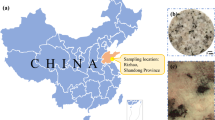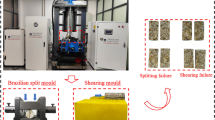Abstract
Thousands of cubic meters of fluid are continuously injected for a long term to create complex fracture patterns in hydraulic fracturing of hot dry rocks. However, the physics and mechanics behind the interaction of fluid–rock are not fully understood at present. To reveal the related damage mechanisms of saturated rock samples such as damage initiation and evolution at various alternative stress levels, a series of in-house laboratory tests were performed on a TAW-series triaxial rock mechanics testing system, combined with ultrasound measurement and acoustic emission (AE) monitoring. After saturation with nano-emulsion and distilled water, ultrasound velocity of longitudinal wave was increased by 40%. Saturation weakens these mechanical parameters such as the crack damage stress ratio, fracture toughness and cohesive strength under different stress conditions. Fluid-saturated rock sample has higher AE hit rate than dry rock sample. Meanwhile, many step-like jumps appeared on the curve of cumulative AE events. Failure envelop, b-value and frequency spectrum were analyzed out to compare the mechanical difference between fluid-saturated and dry rock samples. The experimental results demonstrate that the saturation increased the pore pressure in rocks and further promoted crack propagation in hydraulic fracturing. Moreover, nano-emulsion liquid is more advantageous than distilled water for enhancing fracture complexity. This investigation provides for better understanding of the mechanisms of complex fracture formation in deep geothermal reservoirs.



















Similar content being viewed by others
References
Althaus, E., Friz-Töpfer, A., Lempp, Ch., & Natau, O. (1994). Effects of water on strength and failure mode of coarse-grained granites at 300°C. Rock Mechanics and Rock Engineering, 27(1), 1–21.
ASTM D8044–16. (2016). Standard test method for evaluation of asphalt mixture cracking resistance using the semi-circular bend test (SCB) at intermediate temperatures. West Conshohocken: ASTM International. https://doi.org/10.1520/D8044-16.
Atkinson, B. K. (1987). Fracture mechanics of rock. London: Department of Geological Sciences, University College London, Elsevier. https://doi.org/10.1016/C2009-0-21691-6.
Bai, M., Reinicke, K. M., Teodoriu, C., & Fichter, C. (2012). Investigation on water–rock interaction under geothermal hot dry rock conditions with a novel testing method. Journal of Petroleum Science and Engineering, 90–91, 26–30.
Bauer, S. J., & Handin, J. (1983). Thermal expansion and cracking of three confined water-saturated igneous rocks to 800°C. Rock Mechanics and Rock Engineering, 16(3), 181–198.
Cai, M., Kaiser, P. K., Tasaka, Y., Maejima, T., Morioka, H., & Minami, M. (2004). Generalized crack initiation and crack damage stress thresholds of brittle rock masses near underground excavations. International Journal of Rock Mechanics and Mining Sciences, 41(5), 833–847.
Chaki, S., Takarli, M., & Agbodjan, W. P. (2008). Influence of thermal damage on physical properties of a granite rock: Porosity, permeability and ultrasonic wave evolutions. Construction and Building Materials, 22(7), 1456–1461.
Dai, F., Wei, M. D., Xu, N. W., Zhao, T., & Xu, Y. (2015). Numerical investigation of the progressive fracture mechanisms of four ISRM-suggested specimens for determining the mode I fracture toughness of rocks. Computers and Geotechnics, 69, 424–441.
Evans, K. F., Moriya, H., Niitsuma, H., Jones, R. H., Phillips, W. S., Genter, A., et al. (2005). Microseismicity and permeability enhancement of hydrogeologic structures during massive fluid injections into granite at 3 km depth at the Soultz HDR site. Geophysical Journal International, 160(1), 388–412.
Fjar, E., Holt, R. M., Raaen, A. M., Horsrud, P., & Risnes, R. (2008). Petroleum related rock mechanics (2nd ed., Vol. 53). Amsterdam: Elsevier Science.
Gong, H., Wang, B., Liang, H., Luo, Z., & Cao, Y. (2020). Strategic analysis of China’s geothermal energy industry. Frontiers of Engineering Management. https://doi.org/10.1007/s42524-020-0106-4.
Gringarten, A. C., Witherspoon, P. A., & Ohnishi, Y. (1975). Theory of heat extraction from fractured hot dry rock. Journal of Geophysical Research (1896–1977), 80(8), 1120–1124.
Guo, T., Gong, F., Wang, X., Lin, Q., Qu, Z., & Zhang, W. (2019). Performance of enhanced geothermal system (EGS) in fractured geothermal reservoirs with CO2 as working fluid. Applied Thermal Engineering, 152, 215–230.
Guo, T., Zhang, S., Ge, H., Wang, X., Lei, X., & Xiao, B. (2015). A new method for evaluation of fracture network formation capacity of rock. Fuel, 140, 778–787.
Gutenberg, B., & Richter, C. F. (1950). Seismicity of the earth and associated phenomena. Bulletin of the Seismological Society of America, 40(1), 76.
Hasan, A. S. M., Osman, N. M., Ismail, M. K. A., Albar, A., & Razali, M. (2019). Rock water interaction on the effect of drying and wetting to the mechanical and dynamic properties of tropical weathered granite. Journal of Physics: Conference Series, 1349, 012070.
Jupe, A. J., Green, A. S. P., & Wallroth, T. (1992). Induced microseismicity and reservoir growth at the Fjällbacka hot dry rocks project, Sweden. International Journal of Rock Mechanics and Mining Sciences and Geomechanics Abstracts, 29(4), 343–354.
Kahraman, S. (2007). The correlations between the saturated and dry P-wave velocity of rocks. Ultrasonics, 46(4), 341–348. https://doi.org/10.1016/j.ultras.2007.05.003.
Kohl, T., Evansi, K. F., Hopkirk, R. J., & Rybach, L. (1995). Coupled hydraulic, thermal and mechanical considerations for the simulation of hot dry rock reservoirs. Geothermics, 24(3), 345–359.
Lockner, D. (1993). The role of acoustic emission in the study of rock fracture. International Journal of Rock Mechanics and Mining Sciences and Geomechanics Abstracts, 30(7), 883–899.
Menéndez, B., David, C., & Darot, M. (1999). A study of the crack network in thermally and mechanically cracked granite samples using confocal scanning laser microscopy. Physics and Chemistry of the Earth, Part A: Solid Earth and Geodesy, 24(7), 627–632.
Mignan, A., Landtwing, D., Kästli, P., Mena, B., & Wiemer, S. (2015). Induced seismicity risk analysis of the 2006 Basel, Switzerland, enhanced geothermal system project: Influence of uncertainties on risk mitigation. Geothermics, 53, 133–146.
Nejati, M., Aminzadeh, A., Saar, M. O., & Driesner, T. (2019). Modified semi-circular bend test to determine the fracture toughness of anisotropic rocks. Engineering Fracture Mechanics, 213, 153–171.
Nur, A., & Simmons, G. (1969). The effect of saturation on velocity in low porosity rocks. Earth and Planetary Science Letters, 7(2), 183–193.
Pauwels, H., Fouillac, C., & Criaud, A. (1992). Water-rock interactions during experiments within the geothermal hot dry rock borehole GPK1, Soultz-sous-Foreˆts, Alsace, France. Applied Geochemistry, 7(3), 243–255.
Richards, H. G., Savage, D., & Andrews, J. N. (1992). Granite-water reactions in an experimental hot dry rock geothermal reservoir, Rosemanowes test site, Cornwall, UK. Applied Geochemistry, 7(3), 193–222.
Wan, Z., Zhao, Y., & Kang, J. (2005). Forecast and evaluation of hot dry rock geothermal resource in China. Renewable Energy, 30(12), 1831–1846.
Wang, D., Ge, H., Wang, X., Wang, J., & Meng, F. (2015). The mechanical properties of gas shale under uniaxial stress. In Presented at the 13th ISRM international congress of rock mechanics, international society for rock mechanics and rock engineering, 10–13 May, Montreal, Canada. https://www.onepetro.org/conference-paper/ISRM-13CONGRESS-2015-037.
Wang, D., Ge, H., Wang, X., Wang, J., Meng, F., Suo, Y., et al. (2015b). A novel experimental approach for fracability evaluation in tight-gas reservoirs. Journal of Natural Gas Science and Engineering, 23, 239–249.
Wang, D., Wang, X., Ge, H., Sun, D., & Yu, B. (2020a). Experimental study on the failure mechanisms in brittle shales. ACS Omega, 5(18), 10382–10394.
Wang, D., Wang, X., Ge, H., Sun, D., & Yu, B. (2020b). Insights into the effect of spontaneous fluid imbibition on the formation mechanism of fracture networks in brittle shale: An experimental investigation. ACS Omega, 5(15), 8847–8857.
Wang, T., Ye, X., Liu, Z., Gao, Y., & Zhuang, Z. (2019a). An optimized perforation clusters spacing model based on the frictional shale layer. Science China Physics, Mechanics and Astronomy, 62(11), 114621.
Wang, D., Yu, B., Qin, H., Yan, X., Cheng, W., Liu, Q., et al. (2019). An experimental study on the fracability evaluation of hot dry rock: Using an integrated thermo-mechanical model. In Presented at the ISRM 14th international congress of rock mechanics. Foz do Iguassu, Brazil: Rock Mechanics for Natural Resources and Infrastructure Development.
Wang, D., Yu, B., Yan, X., Sun, D., Han, D., Qin, H., & Zhang, W. (2019). An experimental study on the fracture mechanics characteristics of heat-treated hot dry rock samples under different loading rates. In Presented at the 53rd U.S. rock mechanics/geomechanics symposium, American rock mechanics association, 23–26 June, New York City, New York. https://www.onepetro.org/conference-paper/ARMA-2019-0120.
Wang, D., Zhou, F., Dong, Y., Sun, D., & Yu, B. (2020c). Experimental investigation of thermal effect on fracability index of geothermal reservoirs. Natural Resources Research. https://doi.org/10.1007/s11053-020-09733-0.
Wang, D., Zlotnik, S., Diez, P., Ge, H., Zhou, F., & Yu, B. (2020d). A numerical study on hydraulic fracturing problems via the proper generalized decomposition method. CMES-Computer Modeling in Engineering and Sciences, 122(2), 703–720.
Xie, L., Min, K.-B., & Song, Y. (2015). Observations of hydraulic stimulations in seven enhanced geothermal system projects. Renewable Energy, 79, 56–65.
Yang, R., Huang, Z., Shi, Y., Yang, Z., & Huang, P. (2019). Laboratory investigation on cryogenic fracturing of hot dry rock under triaxial-confining stresses. Geothermics, 79, 46–60.
Yang, S.-Q., Ranjith, P. G., Jing, H.-W., Tian, W.-L., & Ju, Y. (2017). An experimental investigation on thermal damage and failure mechanical behavior of granite after exposure to different high temperature treatments. Geothermics, 65, 180–197.
Yu, Q. L., Ranjith, P. G., Liu, H. Y., Yang, T. H., Tang, S. B., Tang, C. A., et al. (2015). A mesostructure-based damage model for thermal cracking analysis and application in granite at elevated temperatures. Rock Mechanics and Rock Engineering, 48(6), 2263–2282.
Zhang, F., Hu, D. W., Xie, S. Y., & Shao, J. F. (2014). Influences of temperature and water content on mechanical property of argillite. European Journal of Environmental and Civil Engineering, 18(2), 173–189.
Zhang, F., Zhao, J., Hu, D., Skoczylas, F., & Shao, J. (2018). Laboratory investigation on physical and mechanical properties of granite after heating and water-cooling treatment. Rock Mechanics and Rock Engineering, 51(3), 677–694.
Zhang, L., Zhou, F., Mou, J., Pournik, M., Tao, S., Wang, D., et al. (2019). Large-scale true tri-axial fracturing experimental investigation on diversion behavior of fiber using 3D printing model of rock formation. Journal of Petroleum Science and Engineering, 181, 106171.
Zhao, Y., Feng, B., Zhang, G., Shangguan, S., Qi, X., Li, X., et al. (2020). Study of the interaction between the granitic hot-dry rock (HDR) and different injection waters. Acta Geologica Sinica, 94(07), 2115–2123.
Zhou, Z., Cai, X., Zhao, Y., Chen, L., Xiong, C., & Li, X. (2016). Strength characteristics of dry and saturated rock at different strain rates. Transactions of Nonferrous Metals Society of China, 26(7), 1919–1925.
Zhuang, L., Kim, K. Y., Diaz, M., & Yeom, S. (2020). Evaluation of water saturation effect on mechanical properties and hydraulic fracturing behavior of granite. International Journal of Rock Mechanics and Mining Sciences, 130, 104321.
Acknowledgments
This work is financially supported by the National Science Foundation of China (Grant Nos. 51804033 and 51936001), and Jointly Projects of Beijing Natural Science Foundation, and Beijing Municipal Education Commission (Grant No. KZ201810017023).
Author information
Authors and Affiliations
Corresponding authors
Rights and permissions
About this article
Cite this article
Wang, D., Bian, X., Qin, H. et al. Experimental Investigation of Mechanical Properties and Failure Behavior of Fluid-Saturated Hot Dry Rocks. Nat Resour Res 30, 289–305 (2021). https://doi.org/10.1007/s11053-020-09760-x
Received:
Accepted:
Published:
Issue Date:
DOI: https://doi.org/10.1007/s11053-020-09760-x




